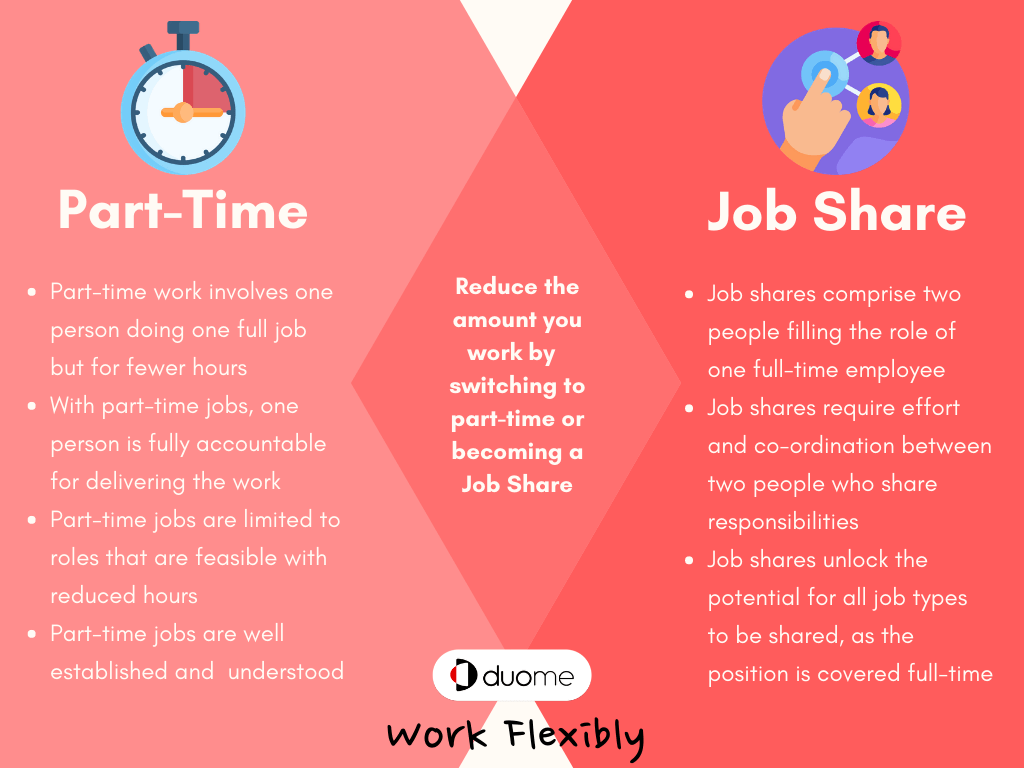How does working part-time differ from being in a job share; after all, they are both ways to reduce the number of hours you work. A part-time job is about reducing the number of hours a job is required to work and, if done well, your employer will redesign the position to lower the output or responsibility – making it manageable. Job share is when two people work part-time hours sharing the full-time roles hours, actively handing over responsibilities, so the position is staffed like other full-time positions.
When it comes to deciding the best way to reduce your hours, how do you determine what’s right for you? Whether job share or part time, both are types of flexible working, yet there are distinct differences in several ways.
- Job shares comprise two people filling the role of one full-time employee, whereas part-time work involves one person doing one full job but for fewer hours.
- Job shares require effort and co-ordination between two people who share responsibilities. With part-time jobs, one person is fully accountable for delivering the work.
- Part-time jobs are limited to roles that are feasible with reduced hours. Job shares unlock the potential for all job types to be shared, as the position is covered full-time.
- Job shares have continuity within the role, with clear handovers and no gaps in productivity. Part-time positions often need the employee to catch-up on days they’ve been away.
The Right Part-Time Opportunities
Part-time roles are readily available and advertised much more frequently than job share roles. These positions cover a broad range of jobs and skills, presenting a good opportunity for people looking to reduce the amount they work. As part-time is a reduction of hours within a role, not all jobs can be made part-time, but very often employers do support employees to make the switch, even in senior positions. Also, managers are familiar with part-time jobs, which makes the working pattern very possible to negotiate.
Part-time roles do have some disadvantages though that should make career-minded people take pause. Ask yourself; do you know successful part-time people in the company? Do you know part-time workers that have been promoted? Will my employer redesign the job that is moving to part-time, how will they do that?
It’s important to ask these questions as the most common issues raised about part-time working are career progression, salary impact, and the job not being designed correctly for part-time working.
As part of the Working Families 2019 Modern Family Index, they reported part-time workers to only have a 21% chance of promotion in the next three years compared to 45% for their full-time colleagues. As significantly more mothers work part-time than fathers, this leads to an additional two-year wait for mothers to be promoted.
Also, there is evidence that moving to part-time work can impact your lifetime earnings potential. The Institute for Fiscal Studies in this report found that women earned 30% less than similarly educated male counterparts by the time their first child was an adult, primarily due to slow wage progression for part-time workers.
Finally, part-time employees frequently stretch themselves beyond what’s required to keep up with their workload, which is not always reflected in their pay package. Without a redesigned part-time role, there is no clear back-up plan for dealing with tasks on the part-time employee’s days off, which can cause them never truly to switch off from work.
Part-time employment is important, and for many people, it provides a readily available option to work fewer hours. For others, though, particularly with a focus on career progression, Job Sharing offers an alternative to get part-time hours whilst still working in a full-time position.
Job Shares Can Achieve Career Growth

The most significant driving force behind job share positions is their capacity for continuity, with clear handovers and joined-up communication between stakeholders, it should perform like any other full-time position. Employees in job share positions maintain an uninterrupted level of productivity within their role and often report getting more done than when they were full-time.
This continuity creates significant opportunities for career growth. Nearly all jobs can be shared, so people wanting to work in a job share have the chance to choose the type of job they would like, typically their existing or chosen career. Job sharers are equal suitability for internal promotion together as their full-time colleagues, with fewer reasons to bias them individually based on working fewer hours.
When colleagues share roles, they feed off each other’s enthusiasm and skill. Job share partnerships play off each other’s strengths, making them more productive. This built-in support system reduces workplace stress, enhances self-awareness in talented employees and leads to increased job satisfaction.
Because days off are covered by the other half of the job share, there is no need to play task catch-up beyond getting updated on progress as part of the handover. Job sharers can entirely switch off on their days off with peace of mind knowing their work isn’t piling up behind them, which further contributes to their improved productivity and job satisfaction when they return to work. Job sharers may at times need to be flexible, but are generally able to stick to their contracted hours and achieve an excellent work-life balance.
There are few disadvantages to job sharing
Job share roles are harder to find and are not entirely accepted by organisations as a generally available flexible working pattern. In these instances, it may be necessary for job share teams to convince the hiring manager, showing how well the job share partnership can perform, and how much the company can benefit from the flexible working arrangement.
Finding the right job share partner is the biggest challenge and essential for applying to jobs not strictly advertised as open to job share. There are many examples of job share teams being successful in applying to full-time roles that did not mention job share.
It is also essential team members think as a unit, and can seamlessly knit their working styles together to demonstrate synergy within the partnership. This can take some time to get the balance right, but once found, job share partners often stay together and progress their careers as a team. For an interview, you must spend sufficient time together to create a shared understanding of how the role will work that you can explain to your prospective employer.
Redesigning an Existing Role into a Part-Time or Job Share Position
When restructuring a full-time position into a part-time role, it’s essential to renegotiate fewer hours alongside a measurably reduced workload. The responsibilities of the smaller role should reflect the new contracted hours, as well as the lower salary, to ensure the role offered really is a part-time position and not just the same responsibilities for less pay. Working Families has a useful guide on job design and workload that may be useful.
Job sharers should take the time to find the right job share partner potentially before looking for a shared position. The partnership should create a joint job share proposal, with a single cover letter outlining their combined suitability for the job offered. Include two CV’s to showcase both employees in their best light. If possible, make the CV’s have the same formatting, so it’s easier for the hiring manager to review and process what’s being presented.
And for real impact, an appendix sheet that explains your operating agreement to explain the logistics of the work pattern. Highlight how key functions might be split, which days you plan to work, potential ways of working, and how accountability will be shared.
Remember, it’s very likely whoever is making the hiring decision may not have managed a job share before so try to make them feel confident that it can work. Some job sharers create a list of commitments they have made to each other that demonstrate how it can work; for instance, we agree to hand over responsibilities in a timely fashion each week.
Hiring a Job Share vs a Part-Time Employee

The decision for which to hire and how is focused around can you realistically make the role a quality part-time role. If you can’t find a way to reduce the work or see how someone could progress in the position part-time, then think about offering it as a job share.
Hiring part-time
For part-time roles, hiring a candidate is usually just a matter of advertising the job and selecting a suitable employee. Due to the wide availability of part-time work, part-time employees are typically plentiful and relatively straightforward to source.
- When hiring for a part-time role, it’s best to assess the hours needed and design the position according to a realistic workload. Taking a full-time job and not changing the work it must perform before switching it to part-time will lead to issues.
- Have a plan for what happens when a part-time worker is out of the office, and questions or enquiries occur. It’s not acceptable to frequently contact a part-time worker on their days off unless it’s critical.
- Have a view for how the role can grow, make it possible for the part-time employee to show their value and perform well. This could include encouraging training or a personal development plan.
If you find it challenging to scope a part-time role with the three points covered above, it’s very likely you aren’t creating a quality part-time role and should think of other options.
Hiring a job share
Hiring a job share team means hiring two candidates, rather than one, which can increase HR and admin costs during the recruitment process. The advantage to doing this is the ability to hire two sets of knowledge and skills, rather than just one, as well as being able to staff any role that requires full-time hours with people working flexibly.
Job share candidates are generally career-driven, usually looking to balance their work-life against their other commitments. These employees frequently seek roles that will allow them to progress, develop their skills, and build on previous experience to push themselves forward within their chosen career.
- If you are recruiting for a full-time position, mark it as open to job share on the job description. Although some job share teams will apply for any full-time role, marking a position open to job share has a significant impact on who will apply.
- Like any other role, design the job to have good future potential; ambitious, career-minded job share teams require a position that will allow them to grow.
- Find the right job share team before designing how the role will operate. Lots of job shares have individuals that are better at certain aspects of some roles so play to the strengths of the team.
Summary
Part-time and job share are good options for people looking to reduce the number of hours they work. Part-time jobs are readily available but can be restricted in terms of what roles can be performed with the reduction of hours properly designed in. Job share roles are harder to find or take some time to create, but these kinds of positions attract top-quality candidates and tend to offer a better path to promotion or career enhancement.
Every job and every employee is unique. Finding the best fit for you and your company is a personal choice. The best solution is the one you feel most comfortable with based on your situation. The good news is these options are out there and getting more focus with employers increasingly offering enhanced flexibility.







